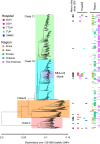The higher prevalence of extended spectrum beta-lactamases among Escherichia coli ST131 in Southeast Asia is driven by expansion of a single, locally prevalent subclone
- PMID: 31519972
- PMCID: PMC6744567
- DOI: 10.1038/s41598-019-49467-5
The higher prevalence of extended spectrum beta-lactamases among Escherichia coli ST131 in Southeast Asia is driven by expansion of a single, locally prevalent subclone
Erratum in
-
Author Correction: The higher prevalence of extended spectrum beta-lactamases among Escherichia coli ST131 in Southeast Asia is driven by expansion of a single, locally prevalent subclone.Sci Rep. 2021 Apr 14;11(1):8563. doi: 10.1038/s41598-021-87312-w. Sci Rep. 2021. PMID: 33854114 Free PMC article. No abstract available.
Abstract
The ST131 multilocus sequence type (MLST) of Escherichia coli is a globally successful pathogen whose dissemination is increasing rates of antibiotic resistance. Numerous global surveys have demonstrated the pervasiveness of this clone; in some regions ST131 accounts for up to 30% of all E. coli isolates. However, many regions are underrepresented in these published surveys, including Africa, South America, and Asia. We collected consecutive bloodstream E. coli isolates from three countries in Southeast Asia; ST131 was the most common MLST type. As in other studies, the C2/H30Rx clade accounted for the majority of ST131 strains. Clinical risk factors were similar to other reported studies. However, we found that nearly all of the C2 strains in this study were closely related, forming what we denote the SEA-C2 clone. The SEA-C2 clone is enriched for strains from Asia, particularly Southeast Asia and Singapore. The SEA-C2 clone accounts for all of the excess resistance and virulence of ST131 relative to non-ST131 E. coli. The SEA-C2 strains appear to be locally circulating and dominant in Southeast Asia, despite the intuition that high international connectivity and travel would enable frequent opportunities for other strains to establish themselves.
Conflict of interest statement
The authors declare no competing interests.
Figures




Similar articles
-
First Report of Prevalence of CTX-M-15-Producing Escherichia coli O25b/ST131 from Iran.Microb Drug Resist. 2017 Oct;23(7):879-884. doi: 10.1089/mdr.2016.0272. Epub 2017 Feb 16. Microb Drug Resist. 2017. PMID: 28437226 Free PMC article.
-
Genomic Analysis of Multidrug-Resistant Escherichia coli from North Carolina Community Hospitals: Ongoing Circulation of CTX-M-Producing ST131-H30Rx and ST131-H30R1 Strains.Antimicrob Agents Chemother. 2017 Jul 25;61(8):e00912-17. doi: 10.1128/AAC.00912-17. Print 2017 Aug. Antimicrob Agents Chemother. 2017. PMID: 28584139 Free PMC article.
-
Arrangements of Mobile Genetic Elements among Virotype E Subpopulation of Escherichia coli Sequence Type 131 Strains with High Antimicrobial Resistance and Virulence Gene Content.mSphere. 2021 Aug 25;6(4):e0055021. doi: 10.1128/mSphere.00550-21. Epub 2021 Aug 25. mSphere. 2021. PMID: 34431692 Free PMC article.
-
Emergence of Escherichia coli ST131 Causing Urinary Tract Infection in Western Asia: A Systematic Review and Meta-Analysis.Microb Drug Resist. 2020 Nov;26(11):1357-1364. doi: 10.1089/mdr.2019.0312. Epub 2020 May 7. Microb Drug Resist. 2020. PMID: 32380906
-
Escherichia coli O25b-ST131: a pandemic, multiresistant, community-associated strain.J Antimicrob Chemother. 2011 Jan;66(1):1-14. doi: 10.1093/jac/dkq415. Epub 2010 Nov 16. J Antimicrob Chemother. 2011. PMID: 21081548 Review.
Cited by
-
Draft Genomic Sequences of Three Escherichia coli Sequence Type 131 Isolates (H45, H43ii, and H43iii) from Patients in Lagos, Nigeria.Microbiol Resour Announc. 2020 Apr 23;9(17):e00076-20. doi: 10.1128/MRA.00076-20. Microbiol Resour Announc. 2020. PMID: 32327517 Free PMC article.
-
Screening of Indonesian peat soil bacteria producing antimicrobial compounds.Saudi J Biol Sci. 2020 Oct;27(10):2604-2611. doi: 10.1016/j.sjbs.2020.05.033. Epub 2020 May 26. Saudi J Biol Sci. 2020. PMID: 32994717 Free PMC article.
-
Antimicrobial Resistance Profiling and Molecular Epidemiological Analysis of Extended Spectrum β-Lactamases Produced by Extraintestinal Invasive Escherichia coli Isolates From Ethiopia: The Presence of International High-Risk Clones ST131 and ST410 Revealed.Front Microbiol. 2021 Aug 2;12:706846. doi: 10.3389/fmicb.2021.706846. eCollection 2021. Front Microbiol. 2021. PMID: 34408737 Free PMC article.
-
In vitro Synergistic Activities of Fosfomycin in Combination with Other Antimicrobial Agents Against Carbapenem-Resistant Escherichia coli Harboring bla NDM-1 on the IncN2 Plasmid and a Study of the Genomic Characteristics of These Pathogens.Infect Drug Resist. 2022 Apr 12;15:1777-1791. doi: 10.2147/IDR.S357965. eCollection 2022. Infect Drug Resist. 2022. PMID: 35437346 Free PMC article.
-
Comparative Genomic Analysis of ST131 Subclade C2 of ESBL-Producing E. coli Isolates from Patients with Recurrent and Sporadic Urinary Tract Infections.Microorganisms. 2023 Jun 21;11(7):1622. doi: 10.3390/microorganisms11071622. Microorganisms. 2023. PMID: 37512795 Free PMC article.
References
Publication types
MeSH terms
Substances
LinkOut - more resources
Full Text Sources
Medical
Research Materials
Miscellaneous

